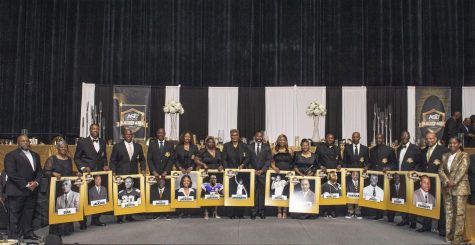SPORTS HALL OF FAME
Athletic department holds “Sports Hall of Fame” banquet, 17 inducted
David Campbell/University Photographer
Alfreeda Abernathy, who finished her career at Alabama State University as the women’s leading scorer in womens’ basketball, thanked the university for the recognition, acknowledgement and honor.
November 12, 2022
“You could be the greatest, you could be the best,” were the words of ‘The Script’ in their famous song “Hall of Fame.”
Those words could not have been more true this Nov.11, as 17 former student-athletes and coaches were inducted into the Alabama State University Sports Hall of Fame.
The purpose of the Hall of Fame is to recognize and pay tribute to former student-athletes and coaches who have demonstrated outstanding accomplishments during their enrollment or career at the University, as well as individuals who have demonstrated significant support to the advancement of the Department of Athletics through dedicated service.

The inductees for this class were: Former basketball player Alfreeda Abernathy who finished her career at Alabama State as the leading scorer in women’s basketball and was named All-Tournament for the Association for Intercollegiate the Athletics for Women (AIAW) all four years. Not only was Abernathy a scorer, she also grabbed over 1,000 career rebounds over the four-year period.
Brad Baxter, was a three-time all-conference performer in the Southwestern Athletic Conference (SWAC) during his time as running back for the Hornets. He finished his career as the school’s all-time leading rusher and scored 30 career touchdowns. He later went on to have an NFL career with the New York Jets.
Former quarterback Darnell Kennedy finished his career as one of the most prolific passers in SWAC history over a four-year span. He finished with 11,753 yards and 102 touchdowns, completing 859 passes. He also piled up 12,888 yards of total offense – both school records.
Lewis Jackson broke into the starting the basketball lineup at Alabama State as a freshman, scoring 2,203 points in his career – the fourth-highest mark at the school. During his senior season, he was named the SWAC Player of the Year, Black College Basketball Player of the Year and a Black College All-American. He was drafted by the Golden State Warriors and earned an invitation to try out for Team USA basketball.
Steve Rogers finished his basketball career as one of the most prolific scorers in SWAC history. He was a First Team All-SWAC selection twice, earning Newcomer of the Year honors as a sophomore. He was named SWAC Player of the Year and earned All-American honors in 1991 and 1992. Rogers finished his career with 2,471 points placing him third all-time at the university. He was a second-round draft choice of the New Jersey Nets.
Reggie Barlow finished his career at Alabama State as the third leading receiver at Alabama State. He hauled in 133 receptions for 2,536 yards with 17 touchdowns. His best season came in 1994 when he caught 58 passes for 1,267 yards and 12 touchdowns. Barlow would go on to win a Super Bowl with Tampa Bay before returning to his alma mater as the head coach.
Reginald Brown, a member of the 1991 HBCU National Championship team, finished his career just one catch behind fellow Hall of Fame selection Barlow. He finished with 132 receptions for 2,271 yards and 23 touchdowns. He recorded 48 receptions for 815 yards and eight touchdowns during the 1990 season.
Rickey Jones, who led Alabama State to the 1991 HBCU National Championship from under center and finished his career as the leader in total offense (he is currently second all-time) with 6,823 yards. He finished his career with 5,456 yards (passing) and 1,273 yards rushing), and he is second all-time in passing (including 49 touchdowns).
Shameka Jackson finished her career as one of the best women’s basketball players in conference history. She earned Player of the Year honors in 2002-03 and was a three-time all-conference selection in her career. She became just the fourth player in conference history to score 2,000 points, finishing with 2,094 – the second-highest mark in conference history.
Former quarterback Tarvaris Jackson was inducted into the Ring of Honor earlier this season and is fourth all-time at the school in passing with 4,898 yards and 38 touchdowns. He also finished his career fourth in total offense with 5,709 total yards and recorded the third best passing season (2004) with 2,556 yards and 20 touchdowns.
Eddie Robinson Jr., a two-time All-SWAC performer and a member of the 1991 HBCU National Championship team, finished his career as a two-time SWAC Defensive Player of the Year selection and Sheridan Black College All-American. He was named the Black College Sports Defensive Player of the Year in 1991 and was named a finalist for the William V. Campbell Trophy before being drafted in the second round of the NFL Draft by the Houston Oilers.
The 1991 Alabama State football team captured the HBCU National Championship with an 11-0-1 record. The team scored four or more points five times in the season, and defeated North Carolina A&T in the Heritage Bowl to win the championship.
George Lockhart was a long-time coach and administrator at the university. He started the baseball program in 1926. His name is on the current home of the university’s gymnasium where the volleyball team and intramurals play.
John Garrick Hardy moved to Montgomery at the age of four and attended Alabama State beginning in ninth grade. He learned to play sports and musical instruments, and currently has the student center named after him on campus.
Olean Black Underwood attended Alabama State from 1968 to 1972 where there were no athletic programs for women. The tennis center for both men’s and women’s tennis stand in her name.
Charles Mitchell became the first player from Alabama State to be drafted into the National Football League (NFL). He later went on to become an assistant coach at Alabama State and a long-time high school coach in Michigan. While a student-athlete, he was a jack of all trades playing quarterback and defensive back and recording 13 interceptions in his first year on defense. He was also a punter and was the first Alabama State student-athlete named to the Blue-Gray Football Game.
Former men’s basketball coach C.J. Dunn served Alabama State for 46 years over his career. He served as the baseball coach, basketball coach, and athletic director, while also serving as the Dean of Students and as a professor. During his time as the head basketball coach, the Hornets won 298 games, the most wins by any team under one coach.
During the program Abernathy recalled her days as an athlete.
“First I must acknowledge that all glory and honor must go to God,” she said. “You might be asking yourself what that means? Well it meant we wanted to score 100 points every game. We won the championship against Troy University.”
“That game will always stick with me because I only scored 46 that game,” Abernathy closed with a final message. “It is with great humbleness that I accept this award from Alabama State University, thank you.”
Each member of the class emphasized the same message, “I would not be who I am if it had not been for Alabama State.” Head football coach Eddie Robinson, Jr. spoke on the importance of this achievement.
“This is a big achievement for me. To be recognized as one of all-time greats at my school is amazing. As a kid from Louisiana coming here was not an easy decision. The only person to offer me an opportunity to play was Coach Markham, nobody else gave me a chance.”
Former Hornet defensive tackle Charles Mitchell spoke on behalf of the team.
“I think all of our success should be credited to coach Markham. I think our team took this school to places that we could have not imagined today. And to be honest, I think it is time for our school to make a conference jump.”
He continued.
“I just want everybody to think about it. I mean we have Dr. Cable is a great man and we have great leadership in Dr. Ross, why not? All the resources and money are there, I think it’s just about us doing it now.”







